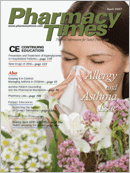A Pharmacist's Guide to OTC Therapy
Ophthalmic Products
An array of OTC ophthalmic productsis available for the self-treatment ofminor ophthalmic disorders.
Dry Eye
Common treatments for minor dry eyeepisodes include the use of OTC ophthalmiclubricants (Table 1), including artificialtear products, as well as nonmedicatedointments and gels. Artificial tearproducts typically contain substitutedcellulose ethers, such as hydroxypropylmethylcellulose, hydroxyethylcellulose,and carboxymethylcellulose.
Other vehicles commonly used includepolyvinyl alcohol and povidone.1 The primaryingredients in OTC ophthalmic ointmentsare white petrolatum, which actsas a lubricant and an ointment base; mineraloil, which assists the ointment inmelting at body temperature; and lanolin,which aids in the absorption of water-solublemedications and also inhibits evaporation.1
Allergic Conjunctivitis
Allergic conjunctivitis, also sometimesreferred to as ocular allergy, is an inflammationof the conjunctiva that is causedby an allergic reaction and is not contagious.It can occur alone or in conjunctionwith nasal allergy symptoms.
Artificial tear products typically areused as the initial therapy. If the symptomspersist, however, OTC ophthalmicproducts such as decongestant and/orantihistamine ocular drops may be warrantedwhen appropriate. The ophthalmicdecongestants available includephenylephrine, naphazoline, tetrahydrozoline,and oxymetazoline (Table 2).Ophthalmic antihistamine products includepheniramine maleate and antazolinephosphate1 (Table 3).
The Role of the Pharmacist
Because these ophthalmic conditionscan negatively impact an individual'squality of life, pharmacists can be afundamental source of information forconsumers seeking relief. Pharmacistsshould ensure that the nature and extentof a patient's ophthalmic condition isthoroughly evaluated and that self-treatmentis appropriate before recommendingany OTC ophthalmic products. Whenwarranted, patients should be advised toseek medical assistance from their ophthalmichealth care provider.
It is important for pharmacists to informpatients with narrow-anterior-chamberor narrow-angle glaucoma thatophthalmic decongestants are inappropriatebecause of the risk of angle-closureglaucoma. Such individuals shouldbe referred to their ophthalmic healthcare provider.1
Patients should be reminded that excessiveuse of ophthalmic decongestantsmay cause rebound congestion of theconjunctiva. In addition, the pharmacistshould suggest that individuals currentlyusing prescription ophthalmic productsconsult their ophthalmologist prior tousing any of the OTC products. Patientsalso should be thoroughly counseled onthe appropriate use and duration of useof these products and the adverse effectsassociated with their use.
Patients should be reminded always towash their hands prior to administrationof these products, as well as to avoidtouching the applicator to prevent contamination.Individuals who wear contactlenses should be advised not to weartheir lenses until the condition improves.In addition, it may be beneficial to informpatients of possible nonpharmacologicmeasures that may be incorporated intothe recommended treatment plan toalleviate the discomfort associated withthese ophthalmic conditions.
For more examples of OTC ophthalmicproducts, see Tables 4 and 5.
Proper Care of SoftContact Lenses
Since soft contact lenses were firstintroduced in the 1970s, many advancesand developments have occurred regardingthe comfort, quality, and ease ofcare for soft contact lenses. Currently,they are available as daily-wear lenses,continuous-wear lenses, disposablelenses, soft toric lenses, and soft bifocallenses. It is estimated that approximately38 million individuals in the UnitedStates currently wear contactlenses. In addition, it is estimatedthat approximately 2.7 millionindividuals annually stopwearing contact lenses primarilydue to lens discomfort.1
Avoiding Complications
Sometimes lens discomfortcan be attributed to impropercare of contact lenses; furthermore,improper lens care mayincrease the incidence of moreserious complications thatmay include corneal infection,corneal ulcers, or other ophthalmicconditions that couldcause permanent eye damage.1 It is therefore imperativethat contact lens wearers thoroughlyunderstand the properprotocol for the care of softcontact lenses to avoid thesecomplications.
The Role of the Pharmacist
Pharmacists can be instrumental inassisting contact lens wearers in productselection, since a myriad of products areavailable for the proper care of soft contactlenses. Table 1 provides examples ofcontact lens products.
These products include surface-activecleaners, enzymatic cleaners,chemical disinfectingsolutions, hydrogen peroxidedisinfecting solutions, preservedsaline solutions, preservative-freesaline solutions, and rewetting/lubricatingsolutions, as well as multipurposesolutions that act as a surface-activecleaner, protein-removal, and disinfectingagent.
Many drug-induced adverse effectsmay occur in individuals who wear contactlenses. These interactions may occurwith the use of topical ophthalmic agentsas well as with many systemic agents,since many systemic agents are secretedinto the tears. See Table 2 for a list ofdrugs that may result in drug/contactlens interactions.
Patients should be informed never towear lenses while using any ophthalmicsolutions, suspensions, ointments, orgels, with the exception of rewettingdrops or those products recommendedby the eye care professional for use withcontact lenses. It is important for softcontact lens wearers to follow a basiccleaning care protocol to avoid possiblecomplications and to utilize only theproducts recommended for use withsoft contact lenses. Patients should beencouraged to remove lenses and seekassistance from their ophthalmic professionalif they experience any problemssuch as redness, pain, excessive tearing,blurry vision, swelling, discharge fromthe eye, or any signs of infection to preventfurther complications.
Ms. Terrie is a clinical pharmacy writerbased in Haymarket,Va.
References
Ophthalmic Products
1. Fiscella R, Jensen M. Opthalmic disorders. In: Berardi RR, Kroon L, McDermott JH, et al, eds. Handbookof Nonprescription Drugs. 15th ed. Washington, DC: American Pharmacists Association; 2006. Chapter 28.
Proper Care of Soft Contact Lenses
2. Engle J. Prevention of contact lens-related discomfort. In: Handbook of Nonprescription Drugs.15th ed. Washington, DC: American Pharmacists Association; 2006: 613-631.

